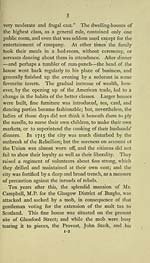Towns > Glasgow > 1787 - Reprint of Jones's directory; or, Useful pocket companion for the year 1787
(14)
Download files
Complete book:
Individual page:
Thumbnail gallery: Grid view | List view

brother magistrates, were enjoying themselves very com-
fortably in a public -house. A detachment of soldiers
arrived from Dumbarton Castle at night; and next day,
as the rioting still continued, they fired twice upon the
crowd, and the result was that nine persons were killed
and seventeen wounded. Intelligence of these troubles
was sent to Edinburgh post-haste; when General Wade
immediately started, for Glasgow, and took possession
of the city with a strong force of cavalry, infantry, and
artillery. He was accompanied by Duncan Forbes of
Culloden, the Lord Advocate of the time; and, after a
searching investigation, nineteen persons were appre-
hended, bound with ropes, and sent off to Edinburgh to
await their trial. But even this was not considered
enough to assert or uphold the majesty of the law. The
whole batch of Glasgow magistrates, from Provost Stark
to the Deacon-Convener, were arrested, thrown into their
own Tolbooth, and afterwards sent to Edinburgh as
prisoners of state. After a day's detention in the capital,
they were liberated on bail, and ultimately absolved from
the charges of negligence or incapacity; but the city had
to pay the piper, in name of damages, to the extent of
^9,000. Shortly after this, Mr. Campbell sold his city man-
sion; and with the price obtained, and the compensation
money, he purchased the entire island of Islay, which his
descendants have since permitted to slip through their fingers.
We now come to the year 1736, when old "John M'Ure,
alias Campbel, Clerk to the Registration of Seisins, and
other Evidents for the District of Glasgow," published
his quaint history of the city. At this date the popu-
lation would not exceed 15,000 persons, living in ten
streets and seventeen lanes, and on an area of ground
fortably in a public -house. A detachment of soldiers
arrived from Dumbarton Castle at night; and next day,
as the rioting still continued, they fired twice upon the
crowd, and the result was that nine persons were killed
and seventeen wounded. Intelligence of these troubles
was sent to Edinburgh post-haste; when General Wade
immediately started, for Glasgow, and took possession
of the city with a strong force of cavalry, infantry, and
artillery. He was accompanied by Duncan Forbes of
Culloden, the Lord Advocate of the time; and, after a
searching investigation, nineteen persons were appre-
hended, bound with ropes, and sent off to Edinburgh to
await their trial. But even this was not considered
enough to assert or uphold the majesty of the law. The
whole batch of Glasgow magistrates, from Provost Stark
to the Deacon-Convener, were arrested, thrown into their
own Tolbooth, and afterwards sent to Edinburgh as
prisoners of state. After a day's detention in the capital,
they were liberated on bail, and ultimately absolved from
the charges of negligence or incapacity; but the city had
to pay the piper, in name of damages, to the extent of
^9,000. Shortly after this, Mr. Campbell sold his city man-
sion; and with the price obtained, and the compensation
money, he purchased the entire island of Islay, which his
descendants have since permitted to slip through their fingers.
We now come to the year 1736, when old "John M'Ure,
alias Campbel, Clerk to the Registration of Seisins, and
other Evidents for the District of Glasgow," published
his quaint history of the city. At this date the popu-
lation would not exceed 15,000 persons, living in ten
streets and seventeen lanes, and on an area of ground
Set display mode to: Large image | Transcription
Images and transcriptions on this page, including medium image downloads, may be used under the Creative Commons Attribution 4.0 International Licence unless otherwise stated. ![]()
| Scottish Post Office Directories > Towns > Glasgow > Reprint of Jones's directory; or, Useful pocket companion for the year 1787 > (14) |
|---|
| Permanent URL | https://digital.nls.uk/85271967 |
|---|
| Description | Directories of individual Scottish towns and their suburbs. |
|---|
| Description | Around 700 Scottish directories published annually by the Post Office or private publishers between 1773 and 1911. Most of Scotland covered, with a focus on Edinburgh, Glasgow, Dundee and Aberdeen. Most volumes include a general directory (A-Z by surname), street directory (A-Z by street) and trade directory (A-Z by trade). |
|---|


